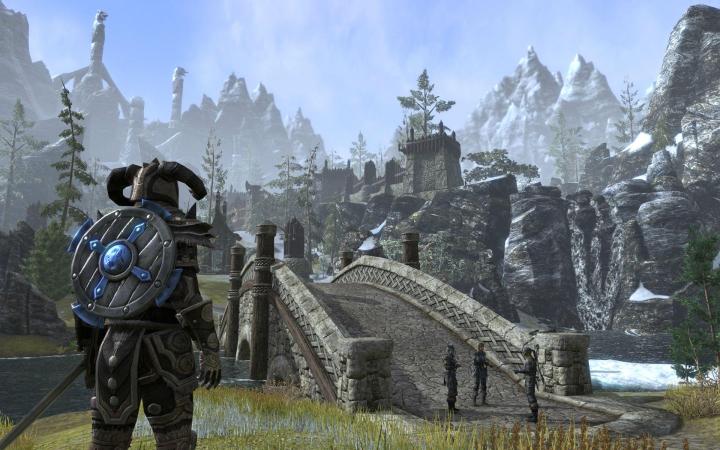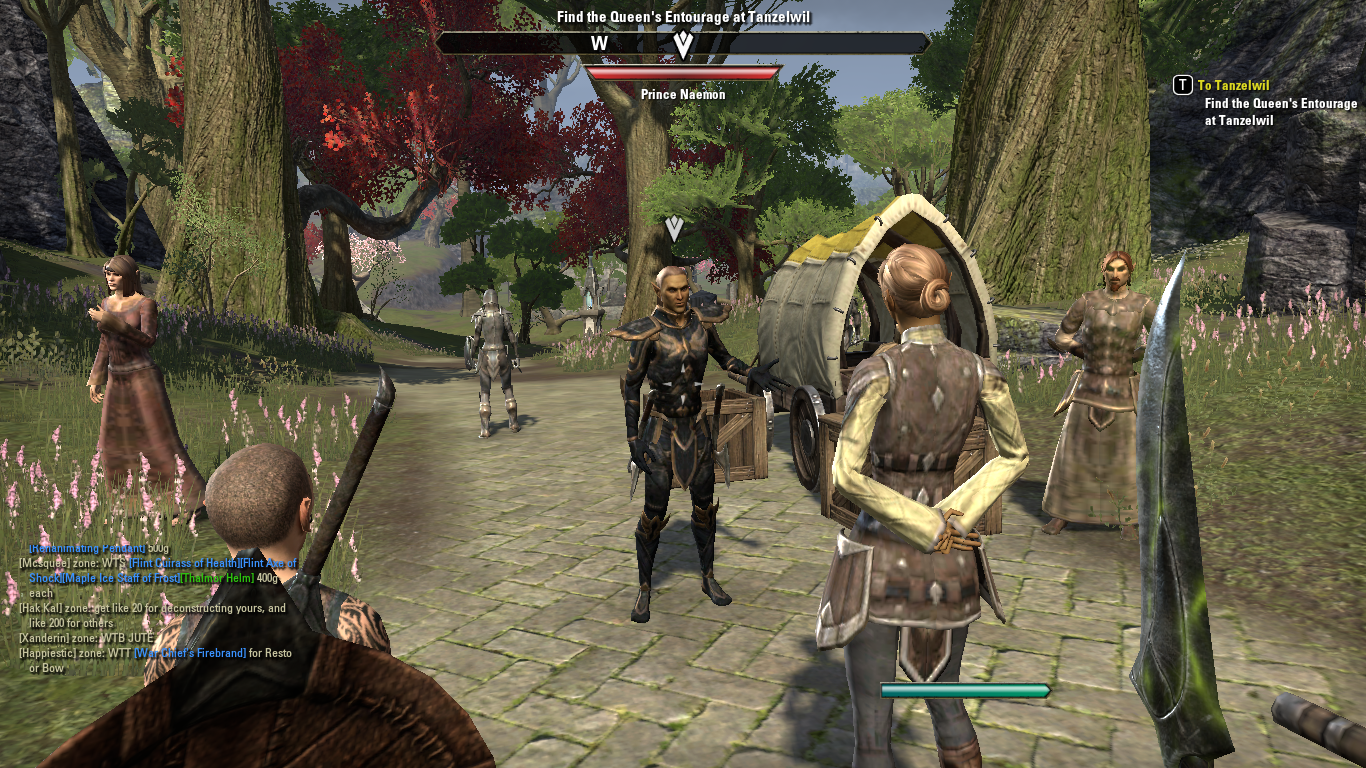
Check out our review of The Elder Scrolls Online.
At first glance, The Elder Scrolls Online appears to be exactly as massive and daunting as the two halves of that equation would make it out to be. ZeniMax Online Studios released what is, first and foremost, a typically content-rich Elder Scrolls game, but with the added twist that makes MMORPGs so addicting: socially driven online play.
There’s no shame in looking for a little guidance before starting up, but you should also know that there’s no single “best” way to play. Think of this more as a set helpful suggestions meant to make sure you get the most complete experience through your starting character’s first 10 levels. After all, even a seasoned pro can use some helpful suggestions.
Character creation

Character creation is probably the biggest hurdle to jump, and it’s unfortunately the first one you face when starting the game. You’re presented with a list of alliances – Daggerfall Covenant, Aldmeri Dominion, and Ebonheart Pact – to which the nine base races belong, three each. If you’ve got the Explorer’s Pack add-on from pre-ordering the game, any race can go with any alliance, and the Imperial Edition of the game also includes access to a tenth race, the Imperials.
The race that you choose is a matter of preference more than anything else. Each has its own skill line that you can develop, as well as some natural differences that should be familiar to longtime Elder Scrolls players. For example, Altmer (High Elf) are better with magic than most, and Nords have frost resistance. The Elder Scrolls Wiki is a great resource for reference info on races (and other topics); take a look if you’d like more specifics on racial differences.

Once you’ve made your choice you’ve got to pick your class. The Elder Scrolls Online currently features four: Dragonknight, Sorcerer, Nightblade, and Templar. Each of these have three main skill lines that are unique to the class, but weapons and armor can be worn by any race or class. Your Sorcerer can run around with a sword while your Templar tosses fire at enemies from a staff. Of the four, Sorcerer is the least focused on melee, and will likely prove the most troublesome to play starting out. Even so, the kind of magic they can produce is totally worth it if you can get past the somewhat rough start.
Stats and skills and gear! Oh my!

The Elder Scrolls Online‘s skill system is similar in some ways to Skyrim‘s, only it’s more elaborate. First you’ve got a master level, which rises as you earn experience points through combat and completing quests. Each time you earn a level, you get an attribute point that you can spend to improve your Health, Magicka, and Stamina ratings and a skill point, which we’ll get to in a moment.

Skill points earned as you level up are spent on unlocking any available abilities within a skill tree. Here’s where we get to the Skyrim comparison. Your character has a wide range of skill trees that are broken into different categories; weapons and armor, class skills, racial skills, crafting skills, alliance skills, guild skills, and world skills (which governs soul magic, lycanthropy, and vampirism). Each individual skill has multiple active and passive abilities – in Skyrim, they were called Perks – connected to it that unlock for “purchase” as that skill’s rating improves through regular use. The skill point you earn when your master level goes up can be spent to buy any of these unlocked abilities, which level up individually as you use them (along with contributing to growth in the skill line they fall under).

There are enough skill points out there that any mistakes or changes in build shouldn’t prove to be a big problem. If you end up deciding you’d have preferred to assign your “One-handed and Shield” skill points or Magicka stat points in a different direction, there are shrines where you can drop some gold to reset them.
You’ll want to be sure to check the stats on items as you collect new gear. You might pick up, say, two pairs of white Rawhide Boots, but they could have completely different Armor values. Each piece of gear has a certain level attached to it, as well as a color-coded quality. So a green item is generally better than a white one, but if said green item is level 6 to the white item’s level 10, the white might actually be better.
To arms! To arms!

Combat feels like a mix between Elder Scrolls mobility and MMO-style hotkey abilities. You move using a standard WASD setup, and double tapping any of these will make your character dash in that direction for a short distance. You run by holding shift down as you move, and you interact with objects and characters by pressing E.
Combat feels like a mix between Elder Scrolls mobility and MMO hotkeys.
Swapping between weapons in the inventory screen takes time; experimentation is good, but you’ll want to settle on a setup that works for you sooner rather than later. At level 15, you get the ability to quickly swap between two different sets of weapons and hotbars. That’s when you’ll want to start thinking about having both a melee setup and ranged setup. It’s best to stick to melee early on; going ranged-only at lower levels can be a pain, as enemies love to close the distance and attack. If your committed to attacking at range, there’s a number of skills that snare or otherwise disable enemies for short periods of time.
Certain skills produce an area of effect that’s visible to others, friend and foe alike. You might encounter casters tossing AoE blasts of fire, for example, and the area this is set to hit will be illuminated before the spell takes effect. You can avoid the majority of these AoE attacks if you dash out of the way as soon as you find yourself inside a spell’s intended area of effect.

When you do start to take damage, it’s good to have your quickslot filled with potions or food for healing. In the midst of a fight, you can tap Q to use whichever item is currently set in your quickslot (which you can change in the inventory screen). It’s worth putting something terrible there over nothing at all, as even the slightest amount of healing can keep you alive long enough to win.
Playing solo is basically impossible at lower levels. That isn’t to say you need to join a party, or that you’re forced to join one, but a number of quests and areas will have other players wandering around in them at the same time. If you start a battle, other players will often jump in to help you finish it off, and the same goes for you hopping into their battles. As long as you get a hit in, you get the same chance at finding loot on the body as you would in solo combat.
Questing, exploring, and hoarding

When you first step out of the tutorial area after making your initial character — you can skip that section with subsequent characters — the first thing you’ll likely notice is how little direction there actually is. The main story is there, but you can also do what you want and wander around as you please. Just like you’d expect from an Elder Scrolls.
Though each alliance starts you out in a different part of the world, quests are quests are quests. Sometimes you’ll be asked to go to a place to get a thing, and sometimes you’ll need to go to a place to kill a thing, and sometimes you’ll need to take a thing to a place. Active quests can be managed via the journal (called up by pressing J), and the solid white arrow on the navigation bar at the top of the screen indicates which direction to travel for your currently selected quest. You’ll also see arrows in the nav bar that aren’t filled in; these point to quests you can take on and complete at your discretion. All quests have an experience level associated with them, which serves as a general guideline for how hard they are.
If you do get beaten to a pulp and your health falls to zero, there are shrines where you resurrect after dying. Your gear durability takes a hit whenever you die, but you can easily repair this damage at most any merchant. Resurrection shrines are also points that you can fast travel to for a small price. They unlock for use the first time you find them, and you can fast-travel to a shrine from anywhere in the world. These locations are often fairly close to larger settlements or quest hubs. Mounts can also ease the pain of traveling in real time if you prefer to avoid spending money on fast-travel, but they cost a significant amount of money to purchase (unless you you got the Imperial horse with the special edition of the game).
Much like any other Elder Scrolls game, it’s highly recommended that you explore every nook, cranny, and crevice. Skyshards are scattered in various locations, and there are also books and various crafting ingredients to pick up along the way. Crafting items might not be as useful early on, but that shouldn’t stop you from hoarding them like an apocalypse is coming. Be aware though: unlike a lot of the other Elder Scrolls games, just because you see a sword on the ground, that doesn’t mean you can grab it. A lot of items exist purely for decoration.
Editors' Recommendations
- The Elder Scrolls 6: release date speculation, rumors, news, and more
- The Elder Scrolls Online’s 2023 updates bring players back to Morrowind
- Starfield, The Elder Scrolls Online devs are voting to unionize
- Is The Elder Scrolls Online worth playing in 2022?
- The Elder Scrolls Online: Everything new in the High Isle Chapter




